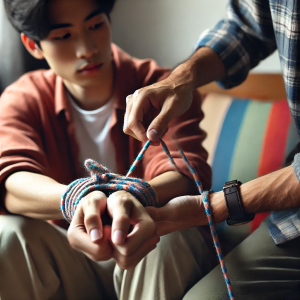Kink and BDSM (Bondage, Discipline, Dominance, Submission, Sadism, and Masochism) are diverse and multifaceted aspects of human sexuality. For those new to these practices, it can be both exciting and intimidating. This guide aims to provide a comprehensive introduction to kink and BDSM, focusing on safe and consensual play.

Contents
What is Kink and BDSM?
Kink refers to unconventional sexual practices, fantasies, or concepts. BDSM, on the other hand, is a specific subset of kink that involves consensual power exchanges and various forms of play. Understanding these terms is the first step towards exploring this exciting realm.
Kink encompasses a wide range of activities and interests that deviate from mainstream sexual norms. These can include anything from foot fetishes to more elaborate role-playing scenarios. What makes an activity “kinky” is subjective and varies from person to person.
BDSM is an umbrella term that covers a variety of practices involving consensual power dynamics. These practices can range from mild forms of bondage and discipline to more intense forms of sadomasochism. The key to BDSM is that all activities are consensual and negotiated beforehand.

The Importance of Consent
Consent is the cornerstone of all BDSM activities. It involves clear, informed, and enthusiastic agreement from all parties. Establishing safe words and boundaries is crucial for ensuring that everyone involved feels secure and respected.
Informed consent means that all participants fully understand what they are agreeing to, including the potential risks and outcomes. This involves detailed discussions about boundaries, limits, and expectations before any activity begins.
Enthusiastic consent goes beyond mere agreement; it requires that all parties are genuinely excited and willing to participate. If someone is hesitant or unsure, it’s important to address those concerns before proceeding.

Safe Words and Communication
Safe words are pre-agreed signals that participants can use to slow down or stop play. Common safe words are “red” for stop, “yellow” for slow down, and “green” for continue. Effective communication before, during, and after play helps build trust and ensures that all parties have a positive experience.
Pre-play negotiations are essential. Discussing limits, desires, and expectations helps prevent misunderstandings and ensures that everyone is on the same page. This conversation should cover what is off-limits, what is desired, and what the safe words will be.
During play, continuous communication is vital. Checking in with each other, using safe words, and being attentive to your partner’s responses can prevent harm and ensure that everyone is enjoying the experience.
Aftercare is the process of caring for each other after a scene. This can involve physical care, like applying lotion to marks, or emotional support, like discussing what happened and how it felt. Aftercare helps partners transition back to everyday life and reinforces trust and connection.

Common BDSM Practices
- Bondage: Involves restraining a partner using ropes, cuffs, or other devices. Safety is paramount, so ensure proper technique and use safe, non-restrictive ties.Bondage safety tips: Always have safety scissors nearby to quickly cut through restraints if needed. Avoid tying too tightly or over sensitive areas like joints or the neck. Regularly check for signs of circulation issues, such as numbness or discoloration.
- Dominance and Submission (D/s): One partner takes control while the other submits. This dynamic can range from mild to intense power exchanges.D/s dynamics: These can be temporary (only during a scene) or part of a long-term relationship dynamic. Some couples enjoy “24/7” D/s relationships, where one partner always holds a dominant role, while others may only engage in D/s during specific scenes.
- Role-Playing: Participants assume roles that allow them to explore different fantasies and power dynamics.Role-playing ideas: This can include teacher/student, boss/employee, or even fantastical scenarios like vampires or superheroes. The key is that both parties agree on the roles and enjoy the fantasy.
- Sensory Play: Involves stimulating the senses using various tools like feathers, ice, or wax.Sensory play techniques: Experiment with different textures and temperatures to find what excites you. Always test the sensation on a less sensitive area of the body first and communicate with your partner about their comfort levels.
- Impact Play: Includes activities like spanking, flogging, or paddling. Always start light and communicate throughout.Impact play guidelines: Understand the difference between thuddy and stingy sensations and learn proper techniques to avoid causing unintended harm. Aim for fleshier parts of the body and avoid areas with bones or vital organs.

Building Trust and Safety

Trust is essential in BDSM relationships. Taking the time to build a strong foundation of trust and understanding helps create a safe environment for exploration. Educate yourself about safety practices, such as avoiding nerve-rich areas during bondage and using aftercare to help partners transition back to everyday life.
Safety education: Many resources are available, from books to workshops, where you can learn about safe practices. Joining a BDSM community can also provide access to experienced practitioners who can offer guidance and support.
Emotional safety: It’s important to check in with your partner not just about physical comfort but also emotional well-being. BDSM play can bring up intense emotions, and having a solid emotional connection and trust is crucial.
Finding Your Community
Many people find support and education through kink communities. Joining local or online BDSM groups can provide valuable resources, mentorship, and a sense of belonging. Always vet these communities to ensure they promote safe, consensual, and respectful practices.
Online communities: Websites and forums dedicated to BDSM can be a good starting point. Look for communities that emphasize consent and safety.
Local meetups: Many cities have BDSM clubs or groups that host educational events, play parties, and social gatherings. Attending these can provide opportunities to learn and meet like-minded individuals.

Aftercare
Aftercare involves the care given to partners after a BDSM scene. It helps them process their experiences and recover emotionally and physically. This can include cuddling, hydration, discussing the scene, or simply spending time together in a comforting environment.
Types of aftercare: Physical aftercare might involve applying lotion to any marks or taking a warm bath. Emotional aftercare could include talking about what each person enjoyed or found challenging and providing reassurance and affection.
Importance of aftercare: Skipping aftercare can lead to “sub drop” or “dom drop,” where the intense emotions from a scene leave someone feeling vulnerable or sad. Proper aftercare helps mitigate these feelings and reinforces trust and connection.
Dr. Amanda Stone is a renowned psychotherapist and BDSM educator with over 15 years of experience in the field of human sexuality. She holds a Ph.D. in Clinical Psychology and has dedicated her career to exploring the intersections of mental health, sexuality, and spirituality. Dr. Stone is a passionate advocate for the healing potential of BDSM and regularly conducts workshops and seminars to educate individuals and couples on safe, consensual, and spiritually enriching BDSM practices.


